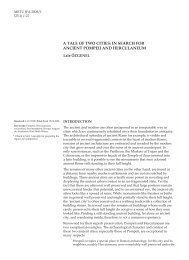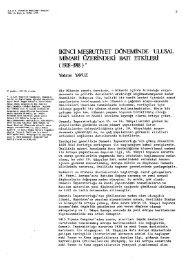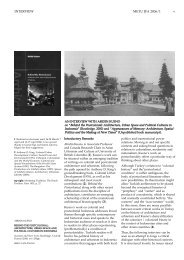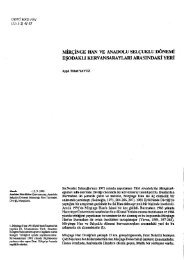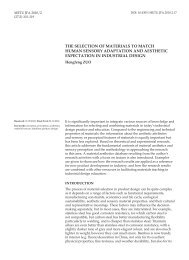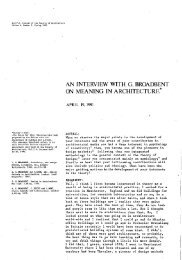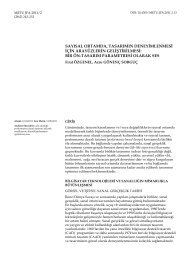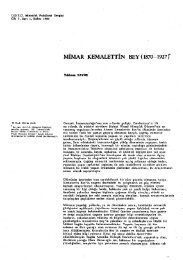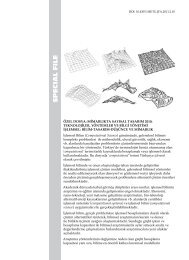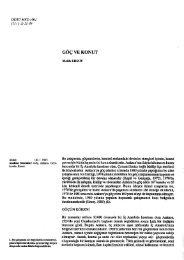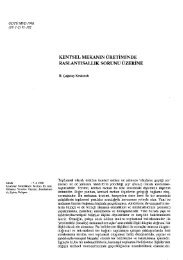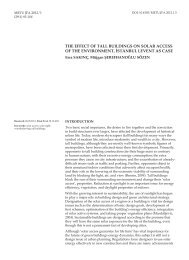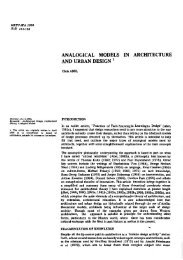bruno taut and the program for the protection of monuments in turkey
bruno taut and the program for the protection of monuments in turkey
bruno taut and the program for the protection of monuments in turkey
Create successful ePaper yourself
Turn your PDF publications into a flip-book with our unique Google optimized e-Paper software.
18 METU JFA 2010/2<br />
10. Taut (1938b, 93-8).<br />
11. Taut (1938b, 95).<br />
12. The graphic layout <strong>of</strong> La Turquie Kemaliste<br />
(issues published between 1934 <strong>and</strong> 1944)<br />
seems to testify a new elaboration <strong>of</strong> radical<br />
cultural approach <strong>of</strong> Republic’s first years,<br />
when <strong>the</strong> myth <strong>of</strong> an <strong>in</strong>dependent Anatolia<br />
embodied by Ankara, <strong>the</strong> core <strong>of</strong> patriotism,<br />
idealism <strong>and</strong> progress was displayed<br />
<strong>in</strong> opposition to İstanbul symbol <strong>of</strong> an<br />
imperialist past people wished to <strong>for</strong>get.<br />
Near to <strong>the</strong> end <strong>of</strong> thirties on <strong>the</strong> contrary<br />
past <strong>and</strong> future, tradition <strong>and</strong> modernity,<br />
new build<strong>in</strong>gs <strong>and</strong> historical <strong>monuments</strong><br />
became <strong>the</strong> dialectics oppositions Turkish<br />
national identity was settled by.<br />
13. Just to mention a few: <strong>in</strong> 1930 <strong>the</strong> Turkish<br />
Historical Society started a scientific research<br />
on Turkish History <strong>and</strong> Civilization whose<br />
historiographical focus was shifted from<br />
Ottoman to Central Anatolian Cultures<br />
(Seljuks, Hittites); <strong>the</strong> Society <strong>for</strong> Research<br />
on Turkish Language as from 1932 headed<br />
a l<strong>in</strong>guistic research aim<strong>in</strong>g at purify<strong>in</strong>g<br />
Turkish from all <strong>for</strong>eign <strong>in</strong>fluences <strong>and</strong> at<br />
detect<strong>in</strong>g its ancient Turkic roots <strong>of</strong> Central<br />
Asia; <strong>in</strong> 1936 Bela Bartok dealt with his<br />
Folk Music Research <strong>in</strong> Turkey with <strong>the</strong><br />
support <strong>of</strong> <strong>the</strong> M<strong>in</strong>istry on <strong>the</strong> traces <strong>of</strong> old<br />
pentatonic folk music style <strong>in</strong> recent Turkish<br />
folk music; <strong>in</strong> 1934 <strong>in</strong> <strong>the</strong> İstanbul F<strong>in</strong>e Arts<br />
Academy Sedat Hakkı Eldem directed <strong>the</strong><br />
Sem<strong>in</strong>ar on National Architecture based<br />
on an extensive documentation <strong>of</strong> Turkish<br />
vernacular build<strong>in</strong>gs.<br />
GIORGIO GASCO<br />
<strong>and</strong> a sterile imitation <strong>of</strong> traditional-historical examples. In spite <strong>of</strong> this<br />
stiff opposition to any <strong>for</strong>malist-stylistic underst<strong>and</strong><strong>in</strong>g <strong>of</strong> architecture,<br />
it was Taut’s def<strong>in</strong>ition <strong>of</strong> <strong>the</strong> strong connections <strong>of</strong> architecture with <strong>the</strong><br />
local features <strong>of</strong> a place <strong>in</strong> terms <strong>of</strong> “national character” that, <strong>in</strong> <strong>the</strong> end,<br />
fasc<strong>in</strong>ated <strong>the</strong> audience at large <strong>in</strong> a country <strong>in</strong> search <strong>of</strong> a proper national<br />
style. Here<strong>in</strong> lies <strong>the</strong> paradox that characterizes <strong>the</strong> relationship between<br />
Taut <strong>and</strong> <strong>the</strong> construction <strong>of</strong> a Turkish national identity. Taut <strong>in</strong> fact <strong>of</strong>ten<br />
stated that “national character” should not be pursued as a ma<strong>in</strong> goal <strong>in</strong><br />
design, clear evidence that he himself was not <strong>in</strong> search <strong>for</strong> a national style<br />
(although o<strong>the</strong>rs were). Never<strong>the</strong>less, his discourse lent itself to be easily<br />
assimilated <strong>in</strong>to <strong>the</strong> stream <strong>of</strong> state rhetoric.<br />
Clear evidence <strong>of</strong> this assimilation comes from an <strong>in</strong>terview Taut gave to<br />
<strong>the</strong> monthly magaz<strong>in</strong>e “Her Ay” (10). In this <strong>in</strong>terview, Taut was skilfully<br />
led by <strong>the</strong> <strong>in</strong>terviewer, which is obvious from <strong>the</strong> article’s title (Türk Evi,<br />
S<strong>in</strong>an, Ankara), to answer questions on <strong>the</strong> three basic <strong>and</strong> key-topics <strong>of</strong><br />
Turkish nationalistic culture: <strong>the</strong> domestic vernacular tradition, <strong>the</strong> master<br />
pieces <strong>of</strong> classical Ottoman architecture designed by S<strong>in</strong>an, <strong>and</strong> <strong>the</strong> ideals<br />
<strong>of</strong> modernity <strong>and</strong> progress as symbolized by <strong>the</strong> new capital. Taut actually<br />
clearly expressed his critical attitude towards nationalist tendencies by<br />
declar<strong>in</strong>g his famous maxim <strong>in</strong> <strong>the</strong> central part <strong>of</strong> <strong>the</strong> <strong>in</strong>terview: “All<br />
nationalist architecture is bad, but all good architecture is national” (11).<br />
The latent ambiguity <strong>of</strong> this sentence seems to be carefully edited <strong>in</strong> order<br />
to w<strong>in</strong>k at <strong>the</strong> nationalist claims <strong>of</strong> <strong>the</strong> time.<br />
Dur<strong>in</strong>g Taut’s years <strong>in</strong> Turkey, <strong>the</strong> Turkish state propag<strong>and</strong>a cont<strong>in</strong>ued<br />
to use <strong>the</strong> <strong>in</strong>itial tempt<strong>in</strong>g images <strong>of</strong> progress <strong>and</strong> modernity that had<br />
dist<strong>in</strong>guished <strong>the</strong> first phase <strong>of</strong> <strong>the</strong> modernization process (1923-1933) but<br />
at <strong>the</strong> same time began to attach a great importance to tak<strong>in</strong>g traditional<br />
elements <strong>in</strong>to consideration, <strong>and</strong> moreover to stress <strong>the</strong> urgency <strong>of</strong><br />
preserv<strong>in</strong>g <strong>the</strong> nation’s historical heritage. This latter aim discloses <strong>the</strong><br />
strategic possibility to cast ancient <strong>monuments</strong> as national icons <strong>in</strong> order to<br />
embody <strong>the</strong> identity <strong>of</strong> <strong>the</strong> roots <strong>of</strong> <strong>the</strong> country.<br />
The same dialectic also characterized <strong>the</strong> publications <strong>of</strong> <strong>the</strong> M<strong>in</strong>istry <strong>of</strong><br />
Education, as <strong>the</strong>y were more <strong>and</strong> more <strong>in</strong>volved <strong>in</strong> a restless propag<strong>and</strong>a<br />
activity. The palimpsests <strong>of</strong> such journals as La Turquie Kemaliste were<br />
effectively conceived on <strong>the</strong> basis <strong>of</strong> this two-fold idea <strong>of</strong> modernity. In<br />
those years, each issue <strong>of</strong> La Turquie Kemaliste displayed several mean<strong>in</strong>gful<br />
images: <strong>the</strong> one, under <strong>the</strong> title Ankara Construit, fostered <strong>the</strong> construction<br />
<strong>of</strong> Ankara as a modern capital city (Figure 1), <strong>the</strong> o<strong>the</strong>r, under <strong>the</strong> title La<br />
Turquie: Pays de soleil de Beauté et d’Histoire, fostered both <strong>the</strong> l<strong>and</strong>scape <strong>of</strong><br />
<strong>the</strong> country <strong>and</strong> its historical-cultural heritage treasures (Figure 2). The<br />
Ankara Construit series, <strong>for</strong>med from architectonic collages display<strong>in</strong>g a<br />
futuristic city made from abstract <strong>and</strong> geometric build<strong>in</strong>gs, symbolized <strong>the</strong><br />
heroic <strong>and</strong> modern side <strong>of</strong> <strong>the</strong> Turkish nation. The La Turquie: Pays de soleil<br />
de Beauté et d’Histoire series, <strong>for</strong>med from classical composed photographs<br />
display<strong>in</strong>g l<strong>and</strong>scape framed with <strong>monuments</strong> <strong>and</strong> fragments, symbolized<br />
<strong>the</strong> traditional <strong>and</strong> romantic side <strong>of</strong> <strong>the</strong> same nation (12).<br />
These images were skilfully used to embody <strong>the</strong> two souls represent<strong>in</strong>g <strong>the</strong><br />
country’s identity; or, <strong>in</strong> o<strong>the</strong>r words, to display <strong>the</strong> two channels through<br />
which <strong>the</strong> national identity was under construction: <strong>the</strong> realization <strong>of</strong> <strong>the</strong><br />
new <strong>and</strong> <strong>the</strong> recovery <strong>of</strong> <strong>the</strong> past. This latter aim especially surfaces to<br />
reconstruct a presumed au<strong>the</strong>nticity that is able to be used as a catalyst<br />
element <strong>in</strong>side <strong>the</strong> def<strong>in</strong>ition <strong>of</strong> a Turkish identity with a more powerful<br />
appeal than simply <strong>the</strong> language <strong>of</strong> modernity.



